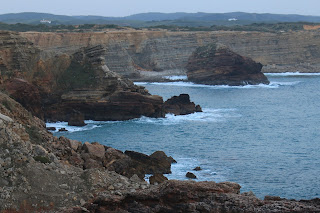The second leg of our Portugal expedition was a road trip from Lisbon south to the wild coast of Algarve. Driving on the well-maintained Highway A2 also called Via Infante de Sagres, we traversed the region of Alentejo, knowns as the 'bread basket of Portugal'. Rolling green hills dotted with yellow wildflowers lead to grazing cows and sheep. Groves of really tall trees as far as we could see. These unusual trees look like long sticks where trunks are stripped to a smooth brown surface and the branches form a tight ball at the very top, llke dark leafy green cotton balls. These are cork oak trees which yield cork, one of the most important exports of Portugal. The Alentejo extends all the way to the coast with small white washed houses with blue stripes and inviting beaches like Cabo Sadrao and Arrifana.

Our destination, Sagres is the south-westernmost tip of continental Europe. In summer, this is a popular beach destination for Europeans but in February we found it to be a quiet village with phenomenal views of cliffs jutting in to the Atlantic. Though the water was too cold to swim in, the sunny days gave us a relaxing break from sight-seeing and souvenir shopping.
The monastery circuit of Alcobaca, Batalha and Fatima is well regarded among the faithful. Along with the religious significance, the monasteries of Alcobaca and Batalha have historical importance to the Portuguese people and have been efficiently preserved and maintained. The monastery at Alcobaca has a striking Gothic facade and a stark interior which reflects its main purpose. This was a house of prayer not celebration. It is also the final resting place of King Pedro I and his murdered mistress Ines Castro.
The monastery of Batalha however, dwarfs the visitor with its grandeur and architecture. Built to commemorate the Portuguese victory over the Spaniards in Aljubberra in 1385, this monastery also served as a burial church for the Aviz dynasty of the Portuguese royalty. The central courtyard and the royal cloisters exhibit more of the Manueline architecture showcased in Jeronomo’s monastery in Lisbon. The wide pointed Gothic archways are layered with elaborate stonework featuring royal symbols of the armillary sphere and the cross of the order of Christ.
Given the importance of the Atlantic ocean in historical and present-day Portugal, we decided to end our trip on its coast. The fishing village of Nazare is quintessentially Portuguese. A well constructed promenade rings the beach and the town is settled around it. Rows of nets hold gutted fish and squid left in the sun to dry and little old ladies wearing traditional dresses and scarves sell roasted chestnuts and dried fish to snack on.
The pace of life here is slow, as is it should be, calling you to relax and let your worries be swept away by the crystal clear green waters of the Atlantic. Here, as everywhere in Portugal, life is meant to be taken one day at at time, savoured like fine port wine and inhaled deeply like the fresh, salty Atlantic breeze.















2 comments:
Nice blog with lot of beautiful pictures. Last year I visited Portugal. So beautiful country and Nazare is one of the best place to visit.
Thank you so much for your comment, "Plan a trip to Portugal". I loved Portugal and cannot wait to go back! Can I ask you how you came to my blog? Please feel free to explore some more of what I have written and share my posts. Take care!
Post a Comment